Support team performance
Enablers
- Appraise team performance against key performance indicators. (ECO 1.3.1)
- Support and recognize team growth and development. (ECO 1.3.2)
- Determine appropriate feedback approach. (ECO 1.3.3)
- Verify team member performance improvements. (ECO 1.3.4)
- Support team task accountability. (ECO 1.4.2)
Deliverables, and Tools
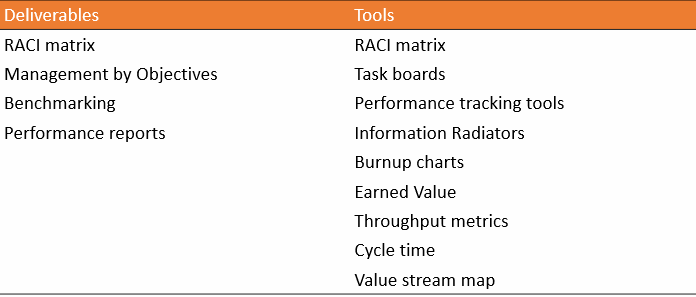
Key Performance Indicators
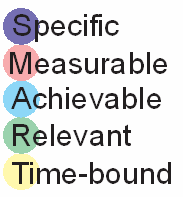
Team Culture and Empowerment
- In projects, the team is the most important part and must be unified.
- Empowering the team to make decisions in a timely manner increases the team’s responsibility to deliver a product with complete ownership.
- Interfering with the team is disruptive and reduces motivation.
- Encourage the team to foster team collaboration and decision making.
- The team should be included in:
- Clarifying and prioritizing requirements
- Splitting requirements into tasks
- Estimating the effort
Team Structure and Workspaces
- Important elements for leading and managing projects is the team’s environment and location.
- Meaningful interaction is a core tenet of agile.
- Team members need to be able to contribute from everywhere and at any time.
- Everyone is engaged at all times and can take initiative when needed.
- Co-locating the team in a shared workspace fosters more informal and immediate collaboration.
- Establishing a culture of fluid communication and engagement in a workspace that promotes positive interactions makes leading and managing a team easier.
Team Building Activities
- Team-building activities are the specific functions or actions taken to help the team to develop into a mature, productive team.
- Using team-building activities to influence diverse individuals from many functional areas, each with their own goals, needs, and perspectives, to work as a cohesive team, for the good of the project.
- Also known as “team-building strategies.”
- Formal or informal.
- Brief or extended.
- Facilitated by the project manager or a group facilitator.
Team Performance Assessments
- Assess and identify the potential of each team member on a continual basis.
- Can be formal or informal.
- Purpose of assessment:
- Improve interaction between team members
- Solve issues
- Deal with conflicts
- Improve skills and competencies of team members
- Increase team cohesiveness
Team Performance Assessments
- Techniques for assessing team performance:
- Ask key questions of the team members.
- Speak to team members frequently through one-to-one meetings and regular project meetings.
- Provide constructive criticism and acclaim to team members, as necessary.
- Encourage knowledge transfer.
- Evaluate individual performance.
- Remove under-performing team members or reassign their work to a new resources.
Performance Assessment Tasks
- Comparing performance to goals.
- Re-clarifying roles and responsibilities.
- Delivering positive as well as negative feedback.
- Discovering unknown or unresolved issues.
- Creating and monitoring individual training plans.
- Establishing future goals.
Team Development Stages
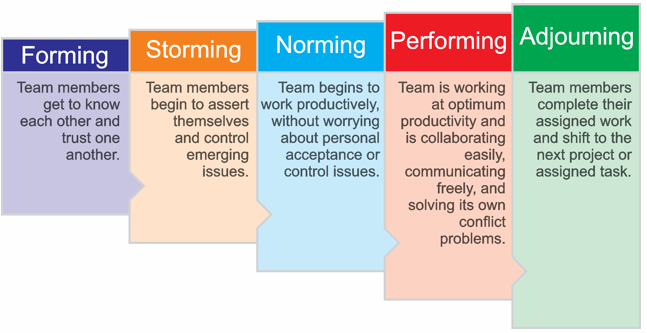
Effective Teams
- The team members should work in a collaborative way to ensure project success.
- It is the responsibility of the project manager to build an effective project team and foster teamwork.
- Managers should give opportunities that challenge the team members' abilities, provide support and timely feedback, and recognize and reward good performance.
- To achieve the best team performance, managers should use effective communication methods, develop trust among team members, manage conflicts, and promote collaborative decision making and problem solving.
Performance Tracking Tools
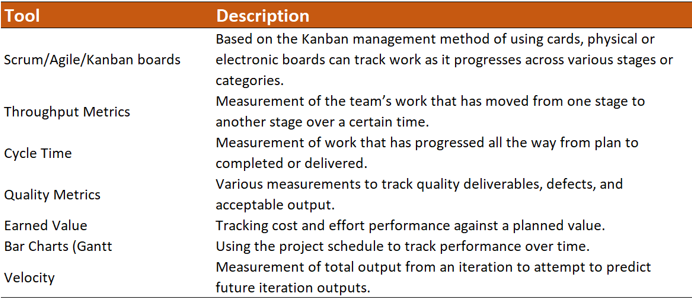
Earned Value Management (EVM)
Earned Value Management (EVM) * is a methodology that combines scope, schedule, and resource measurements to assess project performance and progress during project execution.
- Important to understand the monetary value of work contribution.
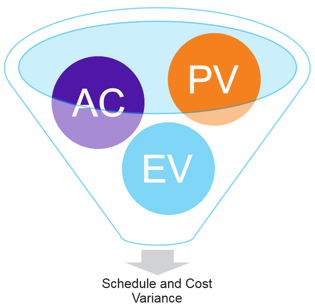
Planned Value
Planned Value (PV) * is the authorized budget assigned to scheduled work.
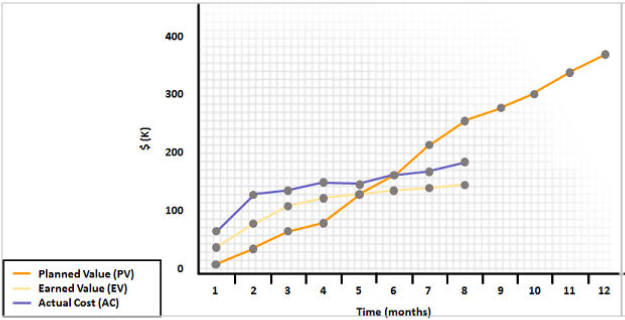
Earned Value
Earned Value (EV) * is the measure of work performed expressed in terms of the budget authorized for that work.
EV = % work complete to date x budgeted cost
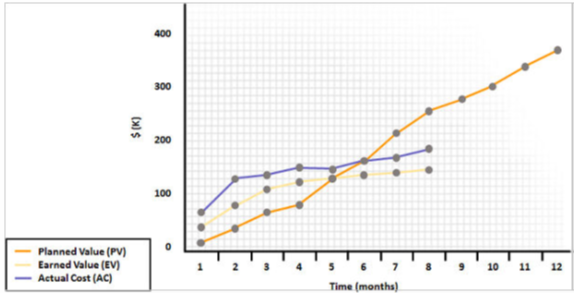
Actual Cost
Actual Cost (AC) * is the realized cost incurred for the work performed on an activity during a specific time period.
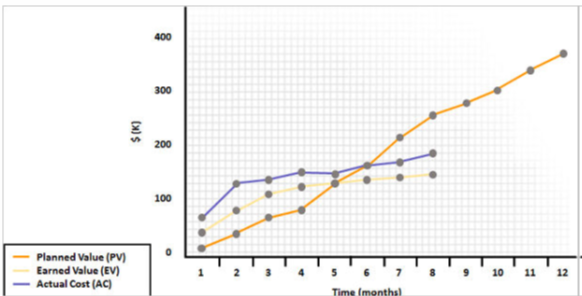
EVM Measures for Schedule Control
Schedule Variance (SV) * is a measure of schedule performance expressed as the difference between the earned value and the planned value.
SV = EV – PV
- A positive SV indicates that the project is ahead of schedule.
- A zero SV indicates that the project is on schedule.
- A negative SV indicates that the project is behind schedule.
Schedule Performance Index (SPI) * is a measure of schedule efficiency expressed as the ratio of earned value to planned value.
SPI = EV / PV
An SPI number greater than 1.0 indicates that the project is ahead of schedule.
An SPI of 1.0 means the project is on schedule.
An SPI number less than 1.0 indicates that the project is behind schedule.
EVM Measures for Cost Control
Cost Variance (CV) * is the amount of budget deficit or surplus at a given point in time, expressed as the difference between the earned value and the actual cost.
CV = EV – AC
- A positive CV indicates that the project is performing under budget.
- A zero CV indicates that the project is on budget.
- • A negative CV indicates that the project is performing over budget.
Cost Performance Index (CPI) * is a measure of the cost efficiency of budgeted resources expressed as the ratio of earned value to actual cost.
CPI = EV / AC
A CPI number greater than 1.0 indicates that the project is under budget.
A CPI of 1.0 means the project is on budget.
A CPI number less than 1.0 indicates that the project is over budget.
Estimate at Completion Analysis
Estimate at Completion (EAC) *: The current projected final cost of the project.
- Based on the current spending efficiency (the CPI).
- Calculated from the following formula, where Budget at Completion (BAC) * is the sum of all budgets established for the work to be performed.

Performance Reports
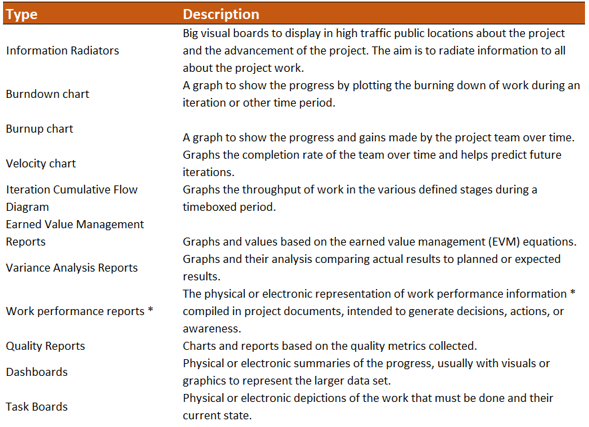
Value Stream Map
Value stream mapping * is a lean enterprise technique used to document, analyze, and improve the flow of information or materials required to produce a product or service for a customer.
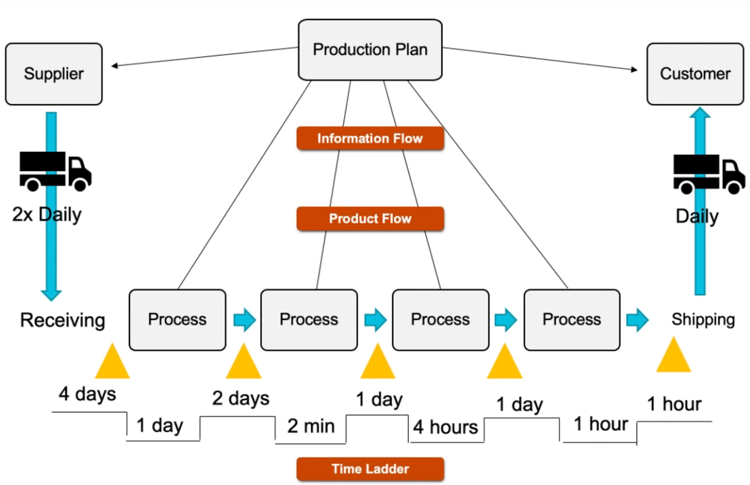
Retrospectives and Lessons Learned
Retrospectives are an important practice in any agile project.
- Gather lessons learned from the team on improvements and recognize successes.
- Encourages the team to review what went well and what could have been better.
Retrospectives are also about applying lessons learned to the next project.
- Involve everyone and respect their input.
- Avoid the blame game and focus on learning and growth opportunities
The result is an improvement plan for the ensuring iteration and beyond.
- Stack rank the opportunities by importance and urgency.
- Incorporate tasks necessary to realize these improvements.
- Apply ideas to the team environment where appropriate.
Guidelines for Conducting a Retrospective
- Prepare mentally or prepare some notes with some ideas or areas of focus in case the team needs some inspiration or ideas.
- Place two large sheets marked “What Went Well” and “What Could Be Improved” on a board.
- Ask the attendees to identify items that went well in the iteration and add them to the first sheet.
- Ask them to identify items that could be improved and add them to the second list.
- Allow each participant to identify the reason for the improvement.
- Ask the moderator to look for common items that need improvement and mark them.
- Narrow the list down to one or two areas to improve upon and bring value in the next Sprint.
- Get team consensus on the plan improvement.
- Update these tasks to the Product Backlog after a discussion with the Product Owner.
- Implement changes.